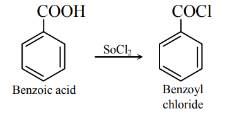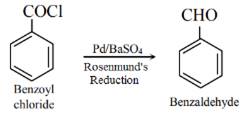(a) Write the product(s) in the following reactions :
(i) 
(ii) 
(iii) 
(b) Give simple chemical tests to distinguish between the following pairs of compounds :
(i) Butanal and Butan-2-one
(ii) Benzoic acid and Phenol
OR
(a) Write the reactions involved in the following :
(i) Etard reaction
(ii) Stephen reduction
(b) How will you convert the following in not more than two steps :
(i) Benzoic acid to Benzaldehyde
(ii) Acetophenone to Benzoic acid
(iii) Ethanoic acid to 2-Hydroxyethanoic acid
(a) (i) ![]()
When  (cyclohexanone) is treated with HCN, it gives
(cyclohexanone) is treated with HCN, it gives 
Explanation:
With pure HCN, the reaction occurs very slowly. Therefore, it is catalyzed by a base.
HO- + H—CN → :CN-‑ + H2O
Now, the nucleophile (:CN-) attack the carbonyl carbon, and the H+ released above attack the negative oxygen:

Note: We can understand the above reaction through the following reaction:

(ii) ![]()

(iii) ![]() CH3—CH=CH—CHO
CH3—CH=CH—CHO
Nitriles can be reduced directly to aldehydes by using DIBAL-H
(diisobutylaluminium hydride)
(b) (i) To distinguish between Butanal (aldehyde) and Butan-2-one (ketone), we will perform a chemical test by using Tollen’s reagent:
Tollens’ reagent is an ammoniacal solution of silver nitrate and is prepared by adding NH4OH solution to AgNO3 solution till the the precipitate of Ag2O first formed just redissolves. When butanal (aldehyde) is heated with Tollens’ reagent, the latter is reduced to metallic silver which deposits on the walls of the test tube as bright silver mirror.
During this reduction, the following reaction occur:
⇒ Formation of Tollens’ reagent:
2AgNO3 + 2NH4OH → Ag2O + 2 NH4NO3 + H2O
![]()
⇒ Now, butanal is treated with Tollens’ reagent:
CH3—CH=CH—CHO + 2[Ag(NH3)2]+ + 3OH- → CH3CH2CH2COO- + 2Ag + 4NH3 + 2H2O
The silver (Ag) thus deposited shines like a mirror. The formation of silver mirror confirms the presence of butanal.
On the other hand, butanone(ketone) does not give this test. It does not form silver with Tollens’ reagent.
(ii) Benzoic acid and Phenol
Benzoic acid and Phenol can be distinguished as follows:
⇒ NaHCO3 test: Benzoic acid being a stronger acid decomposes NaHCO3 to evolve CO2.
C6H5COOH + NaHCO3→ C6H5COONa + CO2 + H2O
Phenol being a weak acid does not give this test.
C6H5OH + NaHCO3→ No evolution of CO2
⇒ FeCl3 test: Phenol gives a violet colouration with neutral FeCl3 solution.
C6H5OH + FeCl3→ Violet colouration
Benzoic acid gives a buff coloured precipitate of ferric benzoate.
C6H5COOH + FeCl3→ (C6H5COO)3Fe + 3HCl
OR
(a) (i) Etard reaction:
Toluene is oxidized to benzaldehyde with a solution of chromyl chloride (CrO2Cl2) in CS2 or CCl4. The brown chromium complex thus precipitated is separated and decomposed with dilute acids to give benzaldehyde.

The above reaction is called Etard reaction.
(ii) Stephen Reaction:
When a solution of a nitrile is reduced with stannous chloride (SnCl2) in the presence of hydrogen chloride gas (HCl) at a room temperature, imine hydrochloride is precipitated. This upon hydrolysis with boiling water give aldehydes.

The above reaction is called Stephen reaction.
(b)(i) Benzoic acid to Benzaldehyde

Step 1: Benzoic acid is treated with SOCl2, to form Benzoyl chloride (C6H5—COCl) by the replacement of OH by Cl atom.

Step 2: Now, Benzoyl chloride is treated with H2/Pd and BaSO4, to form benzaldehyde. This process is called Rosenmund reduction.

(ii) Acetophenone to Benzoic acid

Step 1: Acetophenone reacts with I2/NaOH to form sodium acetate. This reaction is known as Iodoform test due to the formation of a yellow precipitate of iodoform in this reaction.

Step 2: Now, sodium acetate undergoes hydrolysis to form benzoic acid.

(iii) Ethanoic acid to 2-Hydroxyethanoic acid.

Step 1: Ethanoic acid reacts with chlorine or red phosphorus to give 2-chloro ethanoic acid. This reaction is called Hell- Volhard Zelinsky (H.V.Z.) reaction

Step 2: Now, 2-chloro ethanoic acid reacts with KOH to form 2-hydroxyethanoic acid by the replacement of Cl by OH atom.
